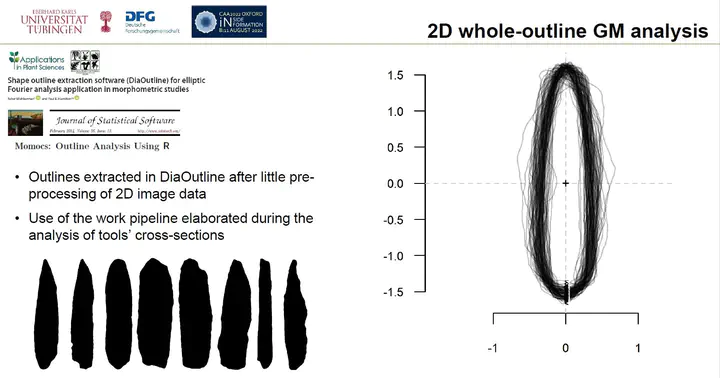Integrating 2D and 3D shape analysis in lithic technology: A discussion around a case study and future research perspectives
 Image credit: Armando Falcucci
Image credit: Armando FalcucciAbstract
Shape analysis in lithic technology is considered a powerful tool to better frame past human behaviour in relation to stone tool manufacture, modification, and use. Despite that, geometric morphometrics is a routinary methodological approach only in a few academic institutions and several well-known Palaeolithic technocomplexes lack of such promising studies. The rarity of shape quantitative approaches is remarkable in the case of European Early Upper Palaeolithic assemblages, which are characterized by a sharp increase in the production of projectile tools, compared to the Middle Palaeolithic. The raising affordability of 3D structured light and laser scanners, coupled with the increased number of researchers willing to share open access repositories, scripts for multivariate statistical analysis, and software packages might in turn represent a turning point. In this framework, 3D applications are usually regarded as more powerful than 2D outline studies because allow to capture the complete, three-dimensional shape of a lithic artifact. Nevertheless, few studies have tried to combine the two approaches to answer specific questions or designed workflows that take into account precise aspects of stone tool variability. In order to address these interrelated problems, I recently developed a 3D scanning protocol relying on micro-computed tomography in collaboration with two colleagues from the University of Tübingen that allowed us to scan several hundreds of small-sized stone tools from a well-known Protoaurignacian site in southern Europe. These scans are available in an open access repository on Zenodo (https://doi.org/10.5281/zenodo.6362150). Taking advantage of this new 3D scanning protocol and open-source software (e.g., Wishkerman and Hamilton 2018; Herzlinger and Grosman 2018), I explored the variability of a large sample of Protoaurignacian tools to assess the selection and modification of bladelets, which had previously been studied using discreet attributes and linear measurements only (Falcucci et al. 2018). In this upcoming study, the 3D geometric morphometric approach was complemented by the 2D analysis of tools’ cross-section outlines using Elliptic Fourier Analysis after the 3D artifacts’ segmentation. Furthermore, I explored the relation between the identified 2D and 3D shape features and other quantitative measurements digitally computed (e.g., 3D volume and mean retouch angles) using multiple regression models and discriminant functional analysis. The identification of multidimensional features characteristic of specific tool types enabled to define the most effective strategy for the ongoing use-wear and experimental analysis of this assemblage. In this paper, I will critically assess the applicability of the different methods employed and I will thus propose a strategy to effectively integrate the amount of data that can be collected from 3D models in relation to specific research-driven questions. I hope that this contribution will emphasize the merits of conducting more integrated studies in lithic technology and stimulate future collaborative research to address some of the existing limitations.